|

< Back to Career archive
1972-1985: The GTV Variety Shows
Several times in my career I have been lucky in falling in with a mentor who taught me more than I could ever have learnt by myself. For instance, it was Lighting Director John MacDowell who taught me perhaps the most important lesson I have ever learnt in the entertainment industry. Push your own department’s interests as hard as possible until it starts to hurt the overall production, then back off a stop and stay there. As Mac wryly pointed out, the trick is to know when your efforts have stopped helping and are starting to hurt the production. When I joined the GTV9 Audio Department, that mentor was Colin Stevenson.
“Col” or “Stevo” as he was known to his crew was an out-and-out audio genius. Stevo pioneered the art of capturing sound so that the audience actually believed they were in the studio, and his specialty was a wonderfully tuned sense of when to go for audience reaction, an asset much appreciated by Graham Kennedy. After working on the last year of IMT with Graham, I was lucky enough to land in the Audio Department just in time for Graham’s return to GTV on 19 September 1972 in “The Graham Kennedy Show”. My role on this production was as boom tracker for boom operator Tony Webb. The boom was quite a mobile affair and, between segments, was tucked away hard up against the audience. If it needed to get somewhere it generally did so in a hurry, and it was my job to follow the boom operator’s hand signals and place the pram exactly where he needed it. Once the boom was finished with, it scurried back to its “home” position near the audience. The boom pram was steered using a handle at the rear of the pram. In its upright position, the handle locked into position and acted as a brake on the rear tyres. The boom tracker could provide quite an exciting time for the front row of the studio audience by hauling the boom back towards them at speed, then flicking the handle into the upright position and stepping away. After a bit of practice you could judge it so that the pram skidded to a halt only feet away from the audience.
In the days before cost-effective and reliable radio mics, the boom was essential if Graham decided to ad-lib, and we always had to be at the host set as soon as he was there. On the opening of one show we came tearing towards the host set in a gentle curve to get to our assigned position in time. As we rounded the curve Tony’s weight shifted and the racking handle, complete with drum, came off in his hand. This totally de-strung the entire boom. With the travelling counterweight now free of all restraint it came hurtling back towards my face and the rear of the boom crashed down on my head. Luckily the padded top of my headphones took the worst of the blow. There was no question of repairing the boom, so Tony sprinted for the adjacent Studio 1 where the spare boom was kept while I hauled the now useless Studio 9 boom back out of the way. This, of course, delighted Graham and he spent most of the first segment doing gags at the expense of the audio department, including hauling Tony up onto the set and demanding to know why he wasn’t running faster. By the end of the first commercial break we had the replacement boom in position and wired up and were back in business.
The days of black and white television were numbered and we had been experimenting with colour for some time. The Engineering Department got hold of an old ex-radio 3AK caravan, stripped the inside, fitted it up as a very cramped OB van using the new Bosch Fernseh Gmbh colour camera chains, and installed a small audio mixer. Just before the caravan was due to be taken off and registered, someone decided that it should be weighed. To everyone’s horror it was well over the weight legally allowed, so all the equipment was stripped out, the empty caravan re-registered, and then it was brought back to the station where all the equipment taken out was promptly re-installed. We used it for some time for trial-recording “Division 4’ in colour and also took it around to various sporting venues to practice telecasting in colour.
We had begun the “Ernie Sigley Show” in early 1974 while Graham was off having a rest. Sometime in 1974, at the end of one of Ernie’s shows, the Studio nine control room was stripped of its old black and white valve equipment by the show crew and new colour equipment was wheeled in and connected up. I spent most of the night under the floor of Studio 9 Audio protecting the audio cables being cut in the frenzy of cable stripping which followed. By lunchtime the following day, the control room was complete ready for the incoming crew to start work on the next Ernie Sigley show – in colour! Of course, the Audio Department maintained that the sound had always been in colour, and I screen-printed up a swag of white T-shirts with black lettering proudly proclaiming “never mind the colour, feel the sound” which the audio department wore for several weeks in a show of departmental solidarity. Meanwhile, the maintenance department was doing a roaring trade making up boards which re-inserted the colour burst (removed at the station for black and white transmission) into colour sets purchased by the staff so we and our families could start watching colour at home. When colour was officially “switched-on” in March 1975, it was a bit of an anticlimax. As I recall, only the ABC made a special effort to commemorate the event with Auntie Jack slowly drowning in a rising sea of colour.
With colour about to be officially established, Graham returned to GTV early in 1975 for a new series of “The Graham Kennedy Show”. It was to be short lived. An imitation “crow call” during a Cedel commercial was the spark that ignited his fiery demise. The incident quickly escalated into an all-out verbal war between Graham, the Australian Broadcasting Control Board and Federal Minister McClelland. Graham’s last show, with the opening remarks edited by station management, went to air at the end of March. “Face Up Came Kennedy”. After some experimentation with stand-in comperes, he was replaced by Don Lane. Don was much different from Graham, who had been fairly reserved with the crew except when on-air. Don was much more open and quickly made friends with most of the production team. Like Ray Martin, he had an uncanny knack for remembering everyone’s names. Variety was back to running four nights a week, with Don doing two nights and Ernie doing two nights. Then Ernie had a big falling-out with management and his show was axed. We continued on with Don hosting four nights a week and a huge cavalcade of overseas stars passed through the doors of Studio 9. We were blessed with an updated band directed by the talented Graeme Lyall and we hosted innumerable international acts (including Sammy Davis Junior, and I’m proud to say I have shaken his hand). Graham’s half-constructed dressing room was named the “Aark” in memory of the crow call and was used as a place for the cast and senior crew to have a drink after the show. It was here that we had the opportunity to meet many of Don’s special guests on an informal basis.
As the 1970s progressed we had been making rapid advances in the standard of television audio under the direction of Col Stevenson. The old and mostly worn-out Mole booms were replaced by new J. L. Fisher booms. We multi-miked drum kits and purchased our first dedicated foldback mixing system. We experimented with stereo. A new custom-designed AWA 48-channel audio console was installed in Studio 9. This was quite innovative but was not without its teething problems. I was the first to use it on air when “Hey Hey it’s Saturday” was still on Saturday mornings. The console started making weird noises shortly after the show started, but luckily the guy who had come down from Sydney to install it was watching the show in his hotel room at the Hilton, and caught a cab into the studio to try and fix the fault. Saturday mornings were pretty much a crazy time even on the best of days, but trying to mix a live show with large sections of the console in pieces made it even more challenging. It was on “Hey Hey it’s Saturday” that I really began my long working relationship with sound effects guru Murray Tregonning. I remember being introduced to Murray on his first day at GTV – I was tracking the boom on the “Graham Kennedy Show”, and Murray was just a kid fresh from a stint at HSV7 – as Murray later remarked, at GTV he thought he had come to Hollywood! Murray and I seemed to “click’ and in the very early days of “Hey Hey” I played some of his sound effects off turntable for him as Studio 1 had only one “cartridge” machine at the time. As his role on “Hey Hey” became more wedded to the part the sound effects played in the production and the show moved to Studio 9 which offered more room and better technical facilities, I took over the mixing role. It was to be a long and fruitful partnership that extended well beyond GTV9 in the years to come.
However, by the late 1970s I had two small children and a wife becoming increasingly less patient with the hours required by a career in television. If I worked too much overtime I was “Never Home”. If I worked too few hours there was “Never Enough Money”. With very early starts on Saturday morning I tended to spend most of Saturday afternoon asleep on the couch. And on the weekday variety shows with a working day starting just after lunch and ending at midnight, there was always pressure for me to forgo a drink with the boys in the “Aark” after the show and to come straight home. And if I did come straight home, she would be fast asleep and I would wander the house for two hours still high on the adrenalin of having been live on air for an hour and a half. Something had to give. I was persuaded to leave GTV and start a business.
Next page >
|
 |
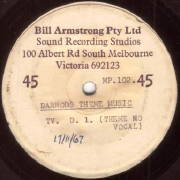
A highlight of all of GTV’s older variety shows was the wheel segment, and the theme, of course, was played “live” off a 45rpm acetate...
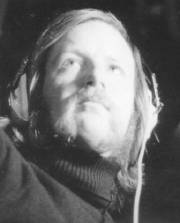
Boom Operator Tony Webb
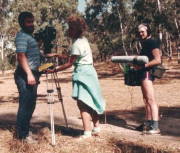
Filming a segment of “Ask the Sigley Brothers”. Left to right: cameraman John Bowering, segment producer Tarni James and sound recordist Peter Evans
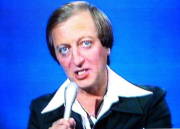
Face Up Comes Kennedy: Graham’s opening remarks on the last Graham Kennedy Show
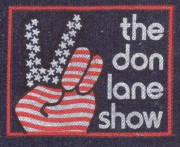
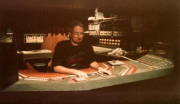
Peter at the 48-channel AWA audio console in Studio 9 audio control

Murray Tregonning, telephone glued to his ear as usual in the 1980s – later it would be replaced by an addiction to
E-mail...
|
